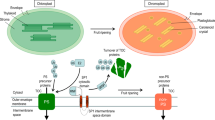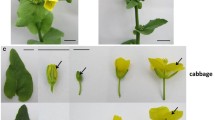Summary
The lethal recessive mutantlycopenic in maize is characterized by the synthesis of lycopene instead of the normal carotenoids. At normal conditions of illumination it loses chlorophyll by photo-oxidation. Seedlings of this mutant and of normal maize were grown at light intensities of 25–30 lux and 500–30,000 lux. Their plastid development was studied by electron microscopy.
At low light intensities a kind of mesophyll chloroplast with elongated grana, long unpaired thylakoid segments, and sometimes prolamellar bodies is formed in mutant plants. In corresponding bleached plants the plastids are transformed into chromoplasts containing characteristic lycopene crystalloids similar to those found in tomato fruits. Various stages in this chromoplast development are described and illustrated. Also bundle-sheath plastids were found to develop into chromoplasts.
It is concluded that the ultrastructure of plastids in a tissue is influenced by the nature of their pigments and that an altered carotenoid composition therefore can give rise to development of chromoplasts in plants which normally lack such organelles.
Similar content being viewed by others
References
Andrés, J. M., 1951: Una nueva mutación que gobierna la sîntesis de la licopina y carotinas en el maiz. Revta. Arg. Agron.18, 136–142.
Bachmann, M. D., D. S. Robertson, andC. C. Bowen, 1969: Thylakoid anomalies in relation to grana structure in pigment-deficient mutants ofZea mays. J. Ultrastruct. Res.28, 435–451.
— — —, andI. C. Anderson, 1967: Chloroplast development in pigment deficient mutants of maize. I. Structural anomalies in plastids of allelic mutants at thew 3 locus. J. Ultrastruct. Res.21, 41–60.
Ben-Shaul, Y., andY. Naftali, 1969: The development and ultrastructure of lycopene bodies in chromoplasts ofLycopersicum esculentum. Protoplasma67, 333–344.
Bisalputra, T., W. J. S. Downton, andE. B. Tregunna, 1969: The distribution and ultrastructure of chloroplasts in leaves differing in photosynthetic carbon metabolism. I. Wheat,Sorghum, andAristida (Gramineae). Can. J. Botany47, 15–21.
Bronchart, R., 1970: Morphology of the prolamellar body as revealed by freeze-etching. VII. Congr. Int. Micr. Électr. Grenoble 1970. Vol.III, 187–188.
Faludi-Dániel, Á., L. Fridvalszky, andI. Gyurjan, 1968: Pigment composition and plastid structure in leaves of carotenoid mutants of maize. Planta78, 184–195.
—,F. Láng, andL. I. Fradkin, 1966: The state of chlorophyll a in leaves of carotenoid mutant maize. In: Biochemistry of Chloroplasts (Goodwin, T. W., ed.), Vol.1, 269–274. London and New York: Acad. Press.
Gunning, B. E. S., 1965: The greening process in plastids. 1. The structure of the prolamellar body. Protoplasma60, 111–130.
—, andM. P. Jagoe, 1967: The prolamellar body. In: Biochemistry of Chloroplasts (Goodwin, T. W., ed.), Vol.2, 655–676. London and New York: Acad. Press.
Harris, W. M., andA. R. Spurr, 1969 a: Chromoplasts of tomato fruits. I. Ultrastructure of low-pigment and high-beta mutants. Carotene analyses. Amer. J. Bot.56, 369–379.
— —, 1969 b: Chromoplasts of tomato fruits. II. The red tomato. Amer. J. Bot.56, 380–389.
Hatch, M. D., andC. R. Slack, 1966: Photosynthesis by sugar cane leaves. A new carboxylation reaction and the pathway of sugar formation. Biochem. J.101, 103–111.
Henningsen, K. W., andJ. E. Boynton, 1969: Macromolecular physiology of plastids. VII. The effect of a brief illumination on plastids of dark-grown barley leaves. J. Cell Sci.5, 757–793.
Jacobson, A. B., 1968: A procedure for isolation of proplastids from etiolated maize leaves. J. Cell Biol.38, 238–244.
Kirk, J. T. O., andB. E. Juniper, 1967: The ultrastructure of the chromoplasts of different colour varieties ofCapsicum. In: Biochemistry of Chloroplasts (Goodwin, T. W., ed.), Vol.2, 691–701. London and New York: Acad. Press.
—, andR. A. E. Tilney-Bassett, 1967: The plastids. London and San Francisco: Freeman & Co.
Kuhn, H., 1970: Chemismus, Struktur und Entstehung der Carotinkriställchen in der Nebenkrone vonNarcissus poeticus L. var. La Riante. J. Ultrastruct. Res.33, 332–355.
Laetsch, W. M., andI. Price, 1969: Development of the dimorphic chloroplasts of sugar cane. Amer. J. Bot.56, 77–87.
Marziani, G., and M.Orsenigo, 1965: Observations on the fine structure of the plastids in a “lycopinic” mutant of maize. A preliminary report. Atti V Congr. Ital. Microscopia Elettronica, Bologna, 158–161.
Menke, W., 1961: Über die Chloroplasten vonAnthoceros punctatus. Z. Naturforsch.16 b, 334–336.
Paolillo, D. J., Jr., andR. H. Falk, 1966: The ultrastructure of grana in mesophyll plastids ofZea mays. Amer. J. Bot.53, 173–180.
Rosado-Alberio, J., E. T. Weier, andC. R. Stocking, 1968: Continuity of the chloroplast membrane system inZea mays L. Plant Physiol.43, 1325–1331.
Rosso, S. W., 1968: The ultrastructure of chromoplast development in red tomatoes. J. Ultrastruct. Res.25, 307–322.
Shumway, L. K., andT. E. Weier, 1967: The chloroplast structure of iojap maize. Amer. J. Bot.54, 773–780.
Spurr, A. R., andW. M. Harris, 1968: Ultrastructure of chloroplasts and chromoplasts inCapsicum annuum. I. Thylakoid membrane changes during fruit ripening. Amer. J. Bot.55, 1210–1224.
Venable, J. H., andR. Coggeshall, 1965: A simplified lead citrate stain for use in electron microscopy. J. Cell Biol.25, 407–408.
Walles, B., 1966: Plastid structures of carotenoid-deficient mutants of sunflower (Helianthus annuus L.). II. The yellow mutant. Hereditas56, 131–136.
—, 1967: Use of biochemical mutants in analyses of chloroplast morphogenesis. In: Biochemistry of Chloroplasts (Goodwin, T. W., ed.), Vol.2, 633–653. London and New York: Acad. Press.
—, 1968: Biochemical mutants affected in chloroplast morphogenesis. Hereditas59, 346–352.
Weier, T. E., 1961: The ultramicro structure of starch-free chloroplasts of fully expanded leaves ofNicotiana rustica. Amer. J. Bot.48, 615–630.
—, andD. L. Brown, 1970: Formation of the prolamellar body in 8-day, dark-grown seedlings. Amer. J. Bot.57, 267–275.
—,C. R. Stocking, andL. K. Shumway, 1966: The photosynthetic apparatus in chloroplasts of higher plants. Brookhaven Symp. Biol.19, 353–374.
Author information
Authors and Affiliations
Rights and permissions
About this article
Cite this article
Walles, B. Chromoplast development in a carotenoid mutant of maize. Protoplasma 73, 159–175 (1971). https://doi.org/10.1007/BF01275592
Received:
Issue Date:
DOI: https://doi.org/10.1007/BF01275592




